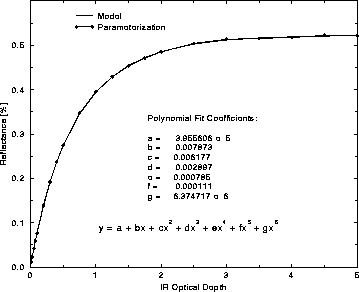Return to the Publications.
Return to the Index.
A phase function can be determined from Mie theory if given the particle size distribution, particle phase, optical depth, and wavenumber. If a particle size distribution is assumed under cirrus conditions for a given microwindow region, the optical depth remains the only unknown.
Reflectance was calculated for a series of optical depths for each microwindow region; where the IR optical depth varied from 0.01 through 5.0. The upper limit is beyond the capabilities of the lidar and is an acceptable cut-off.
Figure 39 shows a plot of reflectance as a function of the
IR optical depth; which is subsequently fit with a sixth-order polynomial to
determine a parameterization for the reflectance for the given optical
depth range. Data shown is at 772 cm![]() . The calculated reflectance for
the given assumptions varies from 0 to 0.52%, among all microwindows.
. The calculated reflectance for
the given assumptions varies from 0 to 0.52%, among all microwindows.

Figure 39: Reflectance as a function of IR optical depth and a sixth-order
polynomial fit for the microwindow region centered at 722 cm![]() . The fit
is required to parameterize reflectance to allow optical depth
inversion from the IR RTE.
. The fit
is required to parameterize reflectance to allow optical depth
inversion from the IR RTE.
The coefficients for each microwindow region are given in Table 9 for completeness, such that
![]()
where the reflectance is valid for infrared optical depths between 0 and 5, and the spectral dependence is implied.
|
(cm | a 10 | b 10 | c 10 | d 10 | e 10 | f 10 | g 10 |
| 773 | 3.9556 | 7.8733 | -6.1774 | 2.8969 | -7.8505 | 1.1149 | -6.3747 |
| 788 | 3.8503 | 7.6638 | -6.0055 | 2.8156 | -7.6313 | 1.0839 | -6.1990 |
| 811 | 3.6348 | 7.1907 | -5.6321 | 2.6428 | -7.1704 | 1.0194 | -5.8339 |
| 820 | 3.5399 | 6.9738 | -5.4638 | 2.5656 | -6.9656 | 0.9908 | -5.6724 |
| 831 | 3.5093 | 6.6325 | -5.2271 | 2.4700 | -6.7406 | 0.9624 | -5.5254 |
| 846 | 3.2853 | 6.1136 | -4.8293 | 2.2878 | -6.2555 | 0.8944 | -5.1399 |
| 862 | 3.0069 | 5.4711 | -4.3383 | 2.0628 | -5.6558 | 0.8102 | -4.6621 |
| 875 | 2.7645 | 4.9264 | -3.9209 | 1.8710 | -5.1439 | 0.7382 | -4.2533 |
| 894 | 2.3410 | 3.9045 | -3.1262 | 1.4978 | -4.1250 | 0.5921 | -3.4095 |
| 902 | 2.1395 | 3.4956 | -2.8113 | 1.3524 | -3.7352 | 0.5372 | -3.0979 |
| 935 | 1.2622 | 1.8554 | -1.5322 | 0.7510 | -2.0987 | 0.3041 | -1.7628 |
| 962 | 1.3547 | 1.9466 | -1.6173 | 0.7948 | -2.2233 | 0.3223 | -1.8688 |
| 992 | 1.9235 | 2.8994 | -2.3775 | 1.1578 | -3.2208 | 0.4653 | -2.6902 |
| 1081 | 2.4633 | 4.0218 | -3.2373 | 1.5550 | -4.2874 | 0.6158 | -3.5472 |
| 1096 | 2.4832 | 4.0746 | -3.2745 | 1.5712 | -4.3288 | 0.6214 | -3.5784 |
| 1115 | 2.5223 | 4.1853 | -3.3529 | 1.6056 | -4.4185 | 0.6338 | -3.6486 |
| 1129 | 2.5462 | 4.2579 | -3.4040 | 1.6281 | -4.4778 | 0.6422 | -3.6958 |
| 1145 | 2.5693 | 4.3299 | -3.4540 | 1.6498 | -4.5338 | 0.6499 | -3.7389 |
| 1159 | 2.5818 | 4.3689 | -3.4799 | 1.6607 | -4.5613 | 0.6536 | -3.7596 |